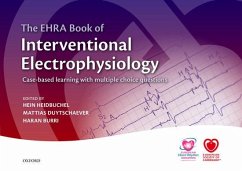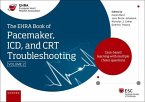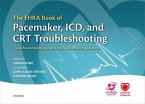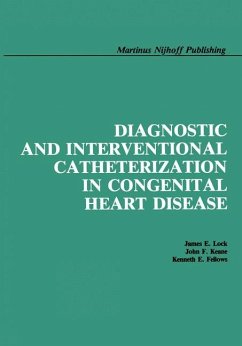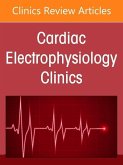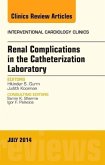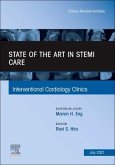The Ehra Book of Interventional Electrophysiology
Case-Based Learning with Multiple Choice Questions
Herausgeber: Heidbuchel, Hein; Duytschaever, Mattias; Burri, Haran
The Ehra Book of Interventional Electrophysiology
Case-Based Learning with Multiple Choice Questions
Herausgeber: Heidbuchel, Hein; Duytschaever, Mattias; Burri, Haran
- Gebundenes Buch
- Merkliste
- Auf die Merkliste
- Bewerten Bewerten
- Teilen
- Produkt teilen
- Produkterinnerung
- Produkterinnerung
The EHRA Book of Interventional Electrophysiology is the second official textbook of European Heart Rhythm Association (EHRA). Taking a case based approach, the textbook it assists device specialists in tackling both common and unusual situations that they may encounter during daily practice.
Andere Kunden interessierten sich auch für
![The Ehra Book of Pacemaker, ICD and CRT Troubleshooting Vol. 2 The Ehra Book of Pacemaker, ICD and CRT Troubleshooting Vol. 2]() The Ehra Book of Pacemaker, ICD and CRT Troubleshooting Vol. 2112,99 €
The Ehra Book of Pacemaker, ICD and CRT Troubleshooting Vol. 2112,99 €![The Ehra Book of Pacemaker, ICD, and CRT Troubleshooting The Ehra Book of Pacemaker, ICD, and CRT Troubleshooting]() The Ehra Book of Pacemaker, ICD, and CRT Troubleshooting122,99 €
The Ehra Book of Pacemaker, ICD, and CRT Troubleshooting122,99 €![Diagnostic and Interventional Catheterization in Congenital Heart Disease Diagnostic and Interventional Catheterization in Congenital Heart Disease]() James E. LockDiagnostic and Interventional Catheterization in Congenital Heart Disease81,99 €
James E. LockDiagnostic and Interventional Catheterization in Congenital Heart Disease81,99 €![The Multifaced Aspects of Atrial Flutter Interpreted by Precision Electrocardiology, an Issue of Cardiac Electrophysiology Clinics The Multifaced Aspects of Atrial Flutter Interpreted by Precision Electrocardiology, an Issue of Cardiac Electrophysiology Clinics]() The Multifaced Aspects of Atrial Flutter Interpreted by Precision Electrocardiology, an Issue of Cardiac Electrophysiology Clinics93,99 €
The Multifaced Aspects of Atrial Flutter Interpreted by Precision Electrocardiology, an Issue of Cardiac Electrophysiology Clinics93,99 €![Renal Complications in the Catheterization Laboratory, an Issue of Interventional Cardiology Clinics Renal Complications in the Catheterization Laboratory, an Issue of Interventional Cardiology Clinics]() Hitinder S GurmRenal Complications in the Catheterization Laboratory, an Issue of Interventional Cardiology Clinics114,99 €
Hitinder S GurmRenal Complications in the Catheterization Laboratory, an Issue of Interventional Cardiology Clinics114,99 €![Controversies in Electrophysiology, an Issue of the Cardiac Electrophysiology Clinics Controversies in Electrophysiology, an Issue of the Cardiac Electrophysiology Clinics]() Emile DaoudControversies in Electrophysiology, an Issue of the Cardiac Electrophysiology Clinics115,99 €
Emile DaoudControversies in Electrophysiology, an Issue of the Cardiac Electrophysiology Clinics115,99 €![State of the Art in Stemi Care, an Issue of Interventional Cardiology Clinics State of the Art in Stemi Care, an Issue of Interventional Cardiology Clinics]() State of the Art in Stemi Care, an Issue of Interventional Cardiology Clinics81,99 €
State of the Art in Stemi Care, an Issue of Interventional Cardiology Clinics81,99 €-
-
-
The EHRA Book of Interventional Electrophysiology is the second official textbook of European Heart Rhythm Association (EHRA). Taking a case based approach, the textbook it assists device specialists in tackling both common and unusual situations that they may encounter during daily practice.
Hinweis: Dieser Artikel kann nur an eine deutsche Lieferadresse ausgeliefert werden.
Hinweis: Dieser Artikel kann nur an eine deutsche Lieferadresse ausgeliefert werden.
Produktdetails
- Produktdetails
- Verlag: Oxford University Press
- Seitenzahl: 320
- Erscheinungstermin: 30. Mai 2017
- Englisch
- Abmessung: 299mm x 218mm x 20mm
- Gewicht: 1150g
- ISBN-13: 9780198766377
- ISBN-10: 0198766378
- Artikelnr.: 47096927
- Herstellerkennzeichnung
- Libri GmbH
- Europaallee 1
- 36244 Bad Hersfeld
- gpsr@libri.de
- Verlag: Oxford University Press
- Seitenzahl: 320
- Erscheinungstermin: 30. Mai 2017
- Englisch
- Abmessung: 299mm x 218mm x 20mm
- Gewicht: 1150g
- ISBN-13: 9780198766377
- ISBN-10: 0198766378
- Artikelnr.: 47096927
- Herstellerkennzeichnung
- Libri GmbH
- Europaallee 1
- 36244 Bad Hersfeld
- gpsr@libri.de
Professor Heidbuchel graduated as MD from the University of Leuven, Belgium, in 1986. He went on to undertake a PhD in Physiology (1992), gained specialist degrees in Internal Medicine (1993) and Cardiology (1995), and a special accreditation in Hospital Administration and Management (2005). He trained as a Resarch Fellow of the NIH at the University of Oklahoma in 1993 and 1994, supported by a Fulbright-Hays grant-in-aid, and was a Fundamental Clinical Investigator of the Fund for Scientific Research Flanders from 1996 to 2006. Professor Heidbuchel worked at the University Hospitals and Faculty of Medicine of the University of Leuven, Belgium, between 1994 and 2014. In 2014 he moved to the Heart Center of the Jessa Hospital and Hasselt University, Belgium. Professor Duytschaever became professor in electrophysiology at the University of Ghent in 2003. Since 2006, he has been conducting diagnostic and interventional electrophysiology at the department of cardiology at St Jan Hospital Bruges. Professor Duytschaever is an active clinical researcher at both institutes and has published widely on the pathogenesis and treatment of arrhythmias. He is a member of the EHRA education committee. Professor Burri is an electrophysiologist involved in ablation and device procedures. He has chaired the EHRA education committee and is also a member of the ESC education committee. He is a Professor at the Medical Faculty of the University of Geneva.
* Case 1: Accessory pathway
* Case 2: IAP in AVNRT patient
* Case 3: Orthodromic AVRT
* Case 4: AVB III infra-Hisian
* Case 5: Para-Hisian pacing: AP
* Case 6: Para-Hisian pacing AVN
* Case 7: Para-Hisian pacing fusion
* Case 8: Atrial tachycardia
* Case 9: Unipolar EGM
* Case 10: Orthodromic AVRT/2
* Case 11: Orthodromic AVRT/3
* Case 12: Orthodromic AVRT/4
* Case 13: Mahaim/1
* Case 14: Adenosine-sensitive AP
* Case 15: Delta-HA in SF AVNRT
* Case 16: Delta-HA in SS AVNRT
* Case 17: AT/1
* Case 18: Bipolar vs unipolar EGM
* Case 19: CTI ablation
* Case 20: PV isolation/1
* Case 21: Mahaim/2
* Case 22: Atypical left atrial flutter/1
* Case 23: PV isolation/2
* Case 24: Activation recovery interval
* Case 25: Double fire tachycardia
* Case 26: Typical AVNRT/1
* Case 27: 2-for-1
* Case 28: Atypical AVNRT
* Case 29: JR with retrograde block
* Case 30: JR after AVNRT
* Case 31: PJRT
* Case 32: Atypical left atrial flutter/2
* Case 33: PV isolation, PVAC
* Case 34: PV isolation/3
* Case 35: Orthodromic AVRT: atrio-fascicular?
* Case 36: Orthodromic AVRT/5
* Case 37: Atypical left atrial flutter/3
* Case 38: Recruitment of bundle branch conduction by VPB
* Case 39: Best ablation electrogram left sided AP ablated via
transseptal approach
* Case 40: AVNRT common, 2:1 AV response
* Case 41: AT/2
* Case 42: PV isolation, lasso
* Case 43: Far-field SVC potential in RSPV
* Case 44: Azygos continuation of interupted SVC
* Case 45: Typical AVNRT/2
* Case 46: SVT inducing VT
* Case 47: VT ablation/1
* Case 48: VT ablation/2
* Case 49: VT ablation/3
* Case 50: Fractionated EGM
* Case 51: VT from proximal His-Purkinje system
* Case 52: Fascicular VT
* Case 53: Mahaim/3
* Case 54: VT ablation/4
* Case 55: VT ablation/5
* Case 56: Fasciculo-ventricular AP
* Case 57: Aortic cusp VPB
* Case 58: Idiopathic VF ablation
* Case 59: VT ablation/6
* Case 60: VT ablation/7
* Case 61: PV isolation/4
* Case 62: Infra-Hisian 2:1 block in SF AVNRT
* Case 63: Ablation site slow pathway
* Case 64: RA free wall flutter, earliest at SD
* Case 65: CW typical flutter
* Case 66: VPB ablation
* Case 67: A-before-A in AVNRT
* Case 68: PV isolation/5
* Case 69: PV isolation/6
* Case 70: Distinguishing retrograde nodal from AP conduction during
VPB
* Case 71: AVNRT: SF or SS?
* Case 72: PV isolation/7
* Case 73: VT ablation/8
* Case 74: PV isolation/8
* Case 75: BBRVT
* Case 76: Slow-fast AVNRT
* Case 2: IAP in AVNRT patient
* Case 3: Orthodromic AVRT
* Case 4: AVB III infra-Hisian
* Case 5: Para-Hisian pacing: AP
* Case 6: Para-Hisian pacing AVN
* Case 7: Para-Hisian pacing fusion
* Case 8: Atrial tachycardia
* Case 9: Unipolar EGM
* Case 10: Orthodromic AVRT/2
* Case 11: Orthodromic AVRT/3
* Case 12: Orthodromic AVRT/4
* Case 13: Mahaim/1
* Case 14: Adenosine-sensitive AP
* Case 15: Delta-HA in SF AVNRT
* Case 16: Delta-HA in SS AVNRT
* Case 17: AT/1
* Case 18: Bipolar vs unipolar EGM
* Case 19: CTI ablation
* Case 20: PV isolation/1
* Case 21: Mahaim/2
* Case 22: Atypical left atrial flutter/1
* Case 23: PV isolation/2
* Case 24: Activation recovery interval
* Case 25: Double fire tachycardia
* Case 26: Typical AVNRT/1
* Case 27: 2-for-1
* Case 28: Atypical AVNRT
* Case 29: JR with retrograde block
* Case 30: JR after AVNRT
* Case 31: PJRT
* Case 32: Atypical left atrial flutter/2
* Case 33: PV isolation, PVAC
* Case 34: PV isolation/3
* Case 35: Orthodromic AVRT: atrio-fascicular?
* Case 36: Orthodromic AVRT/5
* Case 37: Atypical left atrial flutter/3
* Case 38: Recruitment of bundle branch conduction by VPB
* Case 39: Best ablation electrogram left sided AP ablated via
transseptal approach
* Case 40: AVNRT common, 2:1 AV response
* Case 41: AT/2
* Case 42: PV isolation, lasso
* Case 43: Far-field SVC potential in RSPV
* Case 44: Azygos continuation of interupted SVC
* Case 45: Typical AVNRT/2
* Case 46: SVT inducing VT
* Case 47: VT ablation/1
* Case 48: VT ablation/2
* Case 49: VT ablation/3
* Case 50: Fractionated EGM
* Case 51: VT from proximal His-Purkinje system
* Case 52: Fascicular VT
* Case 53: Mahaim/3
* Case 54: VT ablation/4
* Case 55: VT ablation/5
* Case 56: Fasciculo-ventricular AP
* Case 57: Aortic cusp VPB
* Case 58: Idiopathic VF ablation
* Case 59: VT ablation/6
* Case 60: VT ablation/7
* Case 61: PV isolation/4
* Case 62: Infra-Hisian 2:1 block in SF AVNRT
* Case 63: Ablation site slow pathway
* Case 64: RA free wall flutter, earliest at SD
* Case 65: CW typical flutter
* Case 66: VPB ablation
* Case 67: A-before-A in AVNRT
* Case 68: PV isolation/5
* Case 69: PV isolation/6
* Case 70: Distinguishing retrograde nodal from AP conduction during
VPB
* Case 71: AVNRT: SF or SS?
* Case 72: PV isolation/7
* Case 73: VT ablation/8
* Case 74: PV isolation/8
* Case 75: BBRVT
* Case 76: Slow-fast AVNRT
* Case 1: Accessory pathway
* Case 2: IAP in AVNRT patient
* Case 3: Orthodromic AVRT
* Case 4: AVB III infra-Hisian
* Case 5: Para-Hisian pacing: AP
* Case 6: Para-Hisian pacing AVN
* Case 7: Para-Hisian pacing fusion
* Case 8: Atrial tachycardia
* Case 9: Unipolar EGM
* Case 10: Orthodromic AVRT/2
* Case 11: Orthodromic AVRT/3
* Case 12: Orthodromic AVRT/4
* Case 13: Mahaim/1
* Case 14: Adenosine-sensitive AP
* Case 15: Delta-HA in SF AVNRT
* Case 16: Delta-HA in SS AVNRT
* Case 17: AT/1
* Case 18: Bipolar vs unipolar EGM
* Case 19: CTI ablation
* Case 20: PV isolation/1
* Case 21: Mahaim/2
* Case 22: Atypical left atrial flutter/1
* Case 23: PV isolation/2
* Case 24: Activation recovery interval
* Case 25: Double fire tachycardia
* Case 26: Typical AVNRT/1
* Case 27: 2-for-1
* Case 28: Atypical AVNRT
* Case 29: JR with retrograde block
* Case 30: JR after AVNRT
* Case 31: PJRT
* Case 32: Atypical left atrial flutter/2
* Case 33: PV isolation, PVAC
* Case 34: PV isolation/3
* Case 35: Orthodromic AVRT: atrio-fascicular?
* Case 36: Orthodromic AVRT/5
* Case 37: Atypical left atrial flutter/3
* Case 38: Recruitment of bundle branch conduction by VPB
* Case 39: Best ablation electrogram left sided AP ablated via
transseptal approach
* Case 40: AVNRT common, 2:1 AV response
* Case 41: AT/2
* Case 42: PV isolation, lasso
* Case 43: Far-field SVC potential in RSPV
* Case 44: Azygos continuation of interupted SVC
* Case 45: Typical AVNRT/2
* Case 46: SVT inducing VT
* Case 47: VT ablation/1
* Case 48: VT ablation/2
* Case 49: VT ablation/3
* Case 50: Fractionated EGM
* Case 51: VT from proximal His-Purkinje system
* Case 52: Fascicular VT
* Case 53: Mahaim/3
* Case 54: VT ablation/4
* Case 55: VT ablation/5
* Case 56: Fasciculo-ventricular AP
* Case 57: Aortic cusp VPB
* Case 58: Idiopathic VF ablation
* Case 59: VT ablation/6
* Case 60: VT ablation/7
* Case 61: PV isolation/4
* Case 62: Infra-Hisian 2:1 block in SF AVNRT
* Case 63: Ablation site slow pathway
* Case 64: RA free wall flutter, earliest at SD
* Case 65: CW typical flutter
* Case 66: VPB ablation
* Case 67: A-before-A in AVNRT
* Case 68: PV isolation/5
* Case 69: PV isolation/6
* Case 70: Distinguishing retrograde nodal from AP conduction during
VPB
* Case 71: AVNRT: SF or SS?
* Case 72: PV isolation/7
* Case 73: VT ablation/8
* Case 74: PV isolation/8
* Case 75: BBRVT
* Case 76: Slow-fast AVNRT
* Case 2: IAP in AVNRT patient
* Case 3: Orthodromic AVRT
* Case 4: AVB III infra-Hisian
* Case 5: Para-Hisian pacing: AP
* Case 6: Para-Hisian pacing AVN
* Case 7: Para-Hisian pacing fusion
* Case 8: Atrial tachycardia
* Case 9: Unipolar EGM
* Case 10: Orthodromic AVRT/2
* Case 11: Orthodromic AVRT/3
* Case 12: Orthodromic AVRT/4
* Case 13: Mahaim/1
* Case 14: Adenosine-sensitive AP
* Case 15: Delta-HA in SF AVNRT
* Case 16: Delta-HA in SS AVNRT
* Case 17: AT/1
* Case 18: Bipolar vs unipolar EGM
* Case 19: CTI ablation
* Case 20: PV isolation/1
* Case 21: Mahaim/2
* Case 22: Atypical left atrial flutter/1
* Case 23: PV isolation/2
* Case 24: Activation recovery interval
* Case 25: Double fire tachycardia
* Case 26: Typical AVNRT/1
* Case 27: 2-for-1
* Case 28: Atypical AVNRT
* Case 29: JR with retrograde block
* Case 30: JR after AVNRT
* Case 31: PJRT
* Case 32: Atypical left atrial flutter/2
* Case 33: PV isolation, PVAC
* Case 34: PV isolation/3
* Case 35: Orthodromic AVRT: atrio-fascicular?
* Case 36: Orthodromic AVRT/5
* Case 37: Atypical left atrial flutter/3
* Case 38: Recruitment of bundle branch conduction by VPB
* Case 39: Best ablation electrogram left sided AP ablated via
transseptal approach
* Case 40: AVNRT common, 2:1 AV response
* Case 41: AT/2
* Case 42: PV isolation, lasso
* Case 43: Far-field SVC potential in RSPV
* Case 44: Azygos continuation of interupted SVC
* Case 45: Typical AVNRT/2
* Case 46: SVT inducing VT
* Case 47: VT ablation/1
* Case 48: VT ablation/2
* Case 49: VT ablation/3
* Case 50: Fractionated EGM
* Case 51: VT from proximal His-Purkinje system
* Case 52: Fascicular VT
* Case 53: Mahaim/3
* Case 54: VT ablation/4
* Case 55: VT ablation/5
* Case 56: Fasciculo-ventricular AP
* Case 57: Aortic cusp VPB
* Case 58: Idiopathic VF ablation
* Case 59: VT ablation/6
* Case 60: VT ablation/7
* Case 61: PV isolation/4
* Case 62: Infra-Hisian 2:1 block in SF AVNRT
* Case 63: Ablation site slow pathway
* Case 64: RA free wall flutter, earliest at SD
* Case 65: CW typical flutter
* Case 66: VPB ablation
* Case 67: A-before-A in AVNRT
* Case 68: PV isolation/5
* Case 69: PV isolation/6
* Case 70: Distinguishing retrograde nodal from AP conduction during
VPB
* Case 71: AVNRT: SF or SS?
* Case 72: PV isolation/7
* Case 73: VT ablation/8
* Case 74: PV isolation/8
* Case 75: BBRVT
* Case 76: Slow-fast AVNRT

